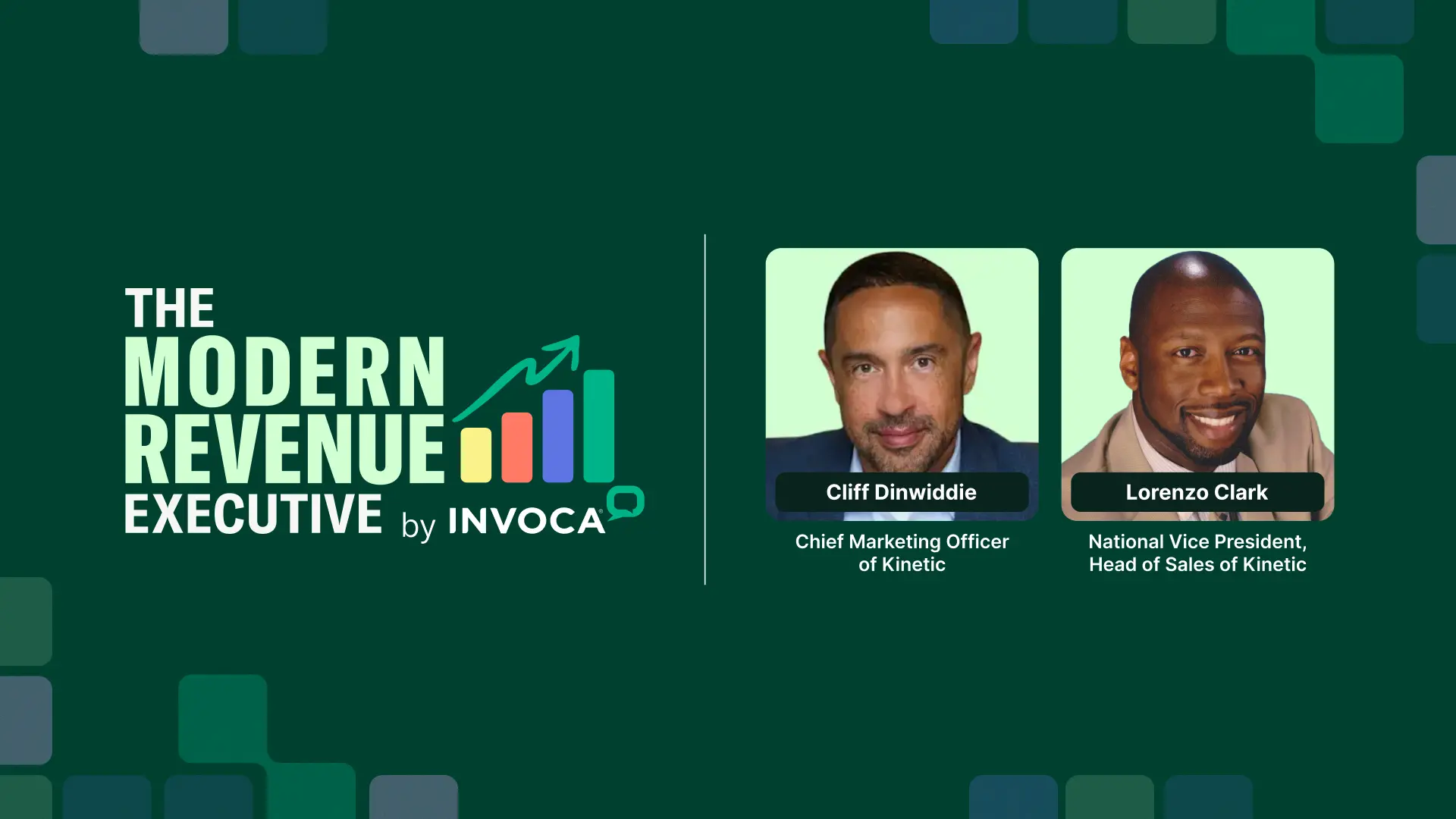In each episode of Invoca’s new podcast, The Modern Revenue Executive, CEO Gregg Johnson meets with revenue leaders from B2C brands to uncover their winning strategies.
In this episode, Gregg sat down with two leaders from Kinetic: CMO Cliff Dinwiddie and National VP and Head of Sales Lorenzo Clark. The conversation was enlightening, as the duo’s partnership has helped drive exceptional sales and revenue growth in the competitive telecommunications industry.
Keep reading to learn the five most important takeaways from the conversation. You can also watch the video below or tune in to your favorite streaming network to catch the whole conversation!
1. Sales and Marketing Must Share One Scoreboard
The foundation of Kinetic's alignment starts with eliminating separate success metrics for sales and marketing teams. Cliff made this crystal clear: "Sure, metrics like your share of voice or click-through rate are interesting to track. But we can’t lose sight of our end goal: to sell our service. We’ve got to keep our eyes on those sales and revenue numbers.”
This philosophy prevents the classic finger-pointing dynamic where marketing blames sales for not converting leads and sales blames marketing for poor lead quality. As Lorenzo explained, "There used to be a lot of finger-pointing between the teams. Then the magic happened when we started focusing on shared KPIs and goals. Now, we can collaborate to hit our numbers."
At Kinetic, this shared accountability manifests in daily standups where both teams examine the same dashboard — sales occupancy, agent performance by tenure, and marketing channel performance all in one view. This transparency creates space for collaborative problem-solving rather than territorial disputes.
2. Start with the Customer's Problem, Not Your Product
When it comes to messaging and positioning, Cliff champions an outside-in approach that begins with understanding what customers are trying to solve. "People are not buying your product. They’re not buying your technology. They’re buying a solution to their problem. And if you don't start the conversation there, it's just a bunch of noise."
This customer-first mentality extends beyond marketing philosophy into execution. Kinetic conducts continuous primary and secondary research to understand evolving customer needs. Sales helps inform this research by sharing the insights it gleans from conversations. They collaborate with marketing to help create messaging that resonates with their audience.
Lorenzo emphasized the collaborative process: "When we create messaging, we start with collaborative workshops between sales and marketing. Both of these teams have unique perspectives to offer, based on how they interact with customers. Combining their strengths helps us understand our customers on a deeper level and put our best foot forward."
The result is messaging that resonates because it addresses real customer pain points rather than product features the company loves but customers don't care about.
3. Create a Carefully Sequenced Customer Journey
Kinetic manages a complex multi-touch journey spanning TV advertising, digital marketing, e-commerce, contact centers, and door-to-door sales. Cliff described their orchestrated approach: "First, we warm the market. Then we warm the door, and as I'm warming that door, I’m delivering a price point that we think is pretty compelling. Then when my partners in sales show up at that door, they’re bringing a slightly improved value proposition, a slightly improved price."
This sequential strategy ensures each touchpoint builds on the previous one. Marketing creates awareness and warms prospects before sales engages. When sales enters the conversation, they bring incremental value that justifies the personal interaction. For prospects who don't convert at the door, marketing follows up with even more targeted offers through email, direct mail, and door hangers.
As Cliff emphasized, "This is absolutely predicated on the relationship between marketing and sales. I cannot win if my partner in sales is not winning. And sales can't win if I'm not winning."
4. Use AI to Enhance Offline Interactions, Not Just Power Digital Ones
While many organizations focus AI investments exclusively on digital channels, Kinetic takes a different approach. They use sophisticated AI and data analytics to supercharge offline interactions like contact center conversations.
Lorenzo explained how it works: "We use Invoca to record and analyze contact center conversations between reps and customers. This allows us to develop better objection handling and coaching techniques based on real-world scenarios."
This data also flows back to marketing to inform messaging across all channels. "We can say, ‘Here are the words that we're using on phone calls that people are reacting positively to, and here are the phrases that aren’t working.’ This approach has allowed us to significantly increase our conversion rates," Lorenzo said.
Utilizing AI in the contact center creates a competitive advantage, enabling Kinetic to refine its sales tactics and gain a deeper understanding of its customers.
5. Build a Culture that Allows for Healthy Disagreement
Beyond tactics and technology, Cliff and Lorenzo emphasized the cultural foundations that make alignment sustainable. This includes creating space for fact-based disagreement without damaging relationships.
Lorenzo shared an example: "In one of our first meetings together, Cliff posed the question, 'Hey, it sounds like we're just doing reporting and updates in these sessions. But what problems are we actually trying to solve?" This helped the team dive deeper and collaborate on a more meaningful level.
Cliff also shared the importance of modeling vulnerability as a leader. "I intentionally point out in front of large groups of people, especially those that report to me, when I think I'm wrong. That kind of vulnerability creates a safe space that helps people do their best work. I want everyone to put their egos aside and contribute ideas, regardless of their title.”
He also distinguished between agreement and alignment: "My agreement isn't always required for my alignment. There are going to be some issues where I see red and someone else sees green, and that's totally fine. As long as we all agree as business partners, we’re going to march down this road for this set of reasons."
This culture of mutual respect creates an environment where teams can challenge ideas without threatening relationships.
Listen to the Full Episode
Want to listen to the full conversation between Gregg, Cliff, and Lorenzo? Tune in to your favorite streaming network below:

